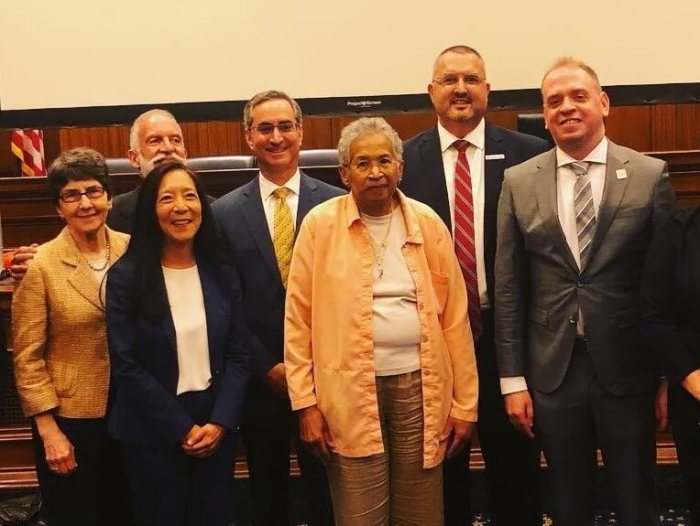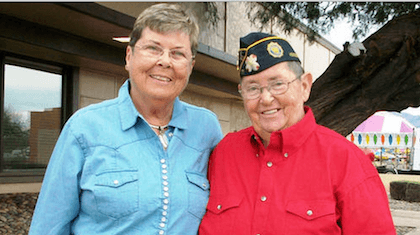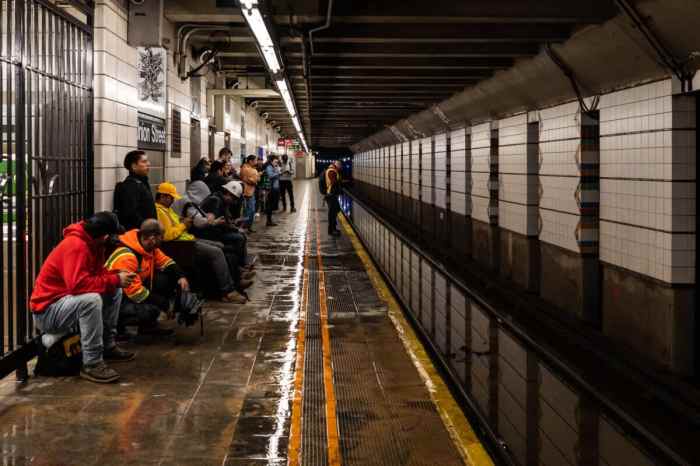When retired Chief Judge Judith Kaye of the New York Court of Appeals died on January 7 at the age of 77, most accounts of her passing mentioned her dissenting opinion in Hernandez v. Robles, the 2006 case in which the state’s highest court voted against the claim that same-sex couples have a constitutional right to marry, as one of her most notable opinions. Her opinion, in the 4-2 case, however, was merely the capstone of a long career on the court during which she often spoke out eloquently in cases important for the rights of gay people as well as those affected by the AIDS epidemic.
Governor Mario Cuomo appointed Kaye to the court early in his first term in 1983, and then elevated her to the position of chief judge in 1993, a post she held until she reached the state constitutional age limit of 70 in late 2008. As of her retirement, she was the longest-serving judge in the Court of Appeals’ history, as well as the longest serving chief judge. Kaye was also the first woman to sit on the state’s highest bench and the first to serve as its chief judge.
At the time of her appointment, Kaye had no judicial experience, having worked as a corporate and litigation lawyer in private practice for most of her career, so Cuomo naming her stirred some controversy. She soon, however, assumed a leading role on the court, especially as a defender of civil rights and minority rights.
Her dissent in case blocking marriage equality in New York State most famous among many forceful opinions
She joined the majority of the court in 1989 in a historic ruling, Braschi v. Stahl Associates Company, which for the first time in American law recognized cohabiting same-sex couples as members of each other’s family –– in this case, for purposes of the state’s Rent Control Law, thus protecting the right of a surviving same-sex partner to take over a lease if their apartment was rented in the name of a deceased partner. Following up on this important ruling, Kaye wrote the court’s 1993 opinion in Rent Stabilization Association of New York v. Higgins, which upheld the New York Division of Housing and Community Renewal’s regulations that extended the Braschi ruling to the far larger rent stabilization system. DHCR had specifically noted the impact of the AIDS epidemic on the housing security of gay men as a justification for the regulation. Kaye rejected the plaintiff’s argument that extending protection to non-traditional families through an administrative regulation was an impermissible legislative act by the agency, and she also rejected the argument that extending this protection had unconstitutionally deprived the owners of property rights.
In 1991, Kaye penned an important dissenting opinion in the case of Alison D. v. Virginia M., when the court ruled that a lesbian co-parent of a child was a “legal stranger” who could not seek court-ordered visitation rights after separating from the child’s birth mother. The court rested its ruling on the formal language of New York’s antiquated Domestic Relations Law, which even today adheres to a vision of families that fails to reflect reality. Kaye criticized the court for exalting legal formality above a central purpose of family law –– protecting the best interests of children.
“The majority’s retreat from the courts’ proper role — its tightening of rules that should in visitation petitions, above all, retain the capacity to take the children’s interests into account — compels this dissent,” she wrote.
The judge argued that a provision of the law requiring the court to take the best interest of children into account should take priority, and that the formal legal definition of a parent should not stand in the way in situations where a person had been an actual parent to a child in a relationship that had been fostered and encouraged by the child’s legal parent.
On the same date as the Alison D. ruling, Kaye joined the majority in an important ruling upholding a determination by the state’s Public Health Council not to list HIV infection as a condition requiring mandatory testing and contact tracing. The Council was concerned that such a listing would prevent infected persons from cooperating with public health officials and impose a barrier to addressing the HIV epidemic. The New York State Society of Surgeons had challenged this decision, but the court held that the Council’s ruling had a rational basis that should not be second-guessed by the court.
In a sharply-divided 4-3 ruling in Matter of Jacob, a 1995 case, Kaye wrote for the majority, creatively interpreting the state’s antiquated adoption statute to allow for second-parent adoptions –– a critically important ruling in mitigating the unfortunate impact of the Alison D. ruling. Since the Court of Appeals considered same-sex coparents to be “legal strangers,” the only way they could protect the relationship with their children would be if they could adopt them, with the permission of their partner. Literally interpreted, the adoption statute would require that the child’s birth parent to relinquish her parental rights upon adoption by a person to whom she was not married. But Kaye found that this would violate the statute’s overall purpose –– the child’s best interest.
“This policy would certainly be advanced in situations like those presented here by allowing the two adults who actually function as a child’s parents to become the child’s legal parents,” she wrote.
After listing all the practical reasons why allowing a second-parent adoption would make sense, Kaye cut to the heart of the matter.
“Even more important,” she wrote, “is the emotional security of knowing that in the event of the biological parent’s death or disability, the other parent will have presumptive custody, and the children’s relationship with their parents, siblings, and other relatives will continue should the coparents separate. Indeed, viewed from the children’s perspective, permitting the adoptions allows the children to achieve a measure of permanency with both parent figures and voids the sort of disruptive visitation battle we faced in Matter of Alison D. v. Virginia M.”
A year later, Judge Kaye provided the crucial vote in a 4-3 decision holding that a dentist’s office is a place of public accommodation, so a dentist would be in violation of the Human Rights Law for refusing treatment to patients the dentist knew or suspected to have HIV infection.
In 2001, Judge Kaye joined with the majority in Levin v. Yeshiva University, ruling that the trial court had wrongly dismissed a sexual orientation discrimination complaint under the New York City Human Rights Law brought against Yeshiva’s Albert Einstein College of Medicine for refusing to allow two lesbian medical students to live with their same-sex partners in married student housing. The case arose before the State Legislature had added sexual orientation to the state’s Human Rights Law, and a majority of the court rejected the plaintiffs’ argument that the College had violated the state law’s ban on marital status discrimination. The court, however, accepted the argument that because the state did not let same-sex couples marry, it was discriminatory on grounds of sexual orientation covered by New York City law to refuse an important benefit to same-sex couples.
Kaye would have gone farther than the court. In a partial dissent, she argued that the marital status complaint should not be dismissed either, finding that the court’s earlier recognition in Braschi that same-sex partners could constitute a family should be taken into account.
“At the very least,” she wrote, “it is a question of fact whether plaintiffs’ life partners qualify as members of their ‘immediate families.’ If they do, the State and City Human Rights Laws prohibit [the medical school] from denying them partner housing merely because they are unmarried. Since discovery and fact finding on this issue are necessary, the lower courts improvidently granted [the school’s] motion to dismiss.”
Kaye pointed out that prior cases interpreted the “marital status” provision in the state law to ban discrimination against somebody because they are “single, married, divorced, separated, or the like.” In this case, she said, the plaintiffs were alleging that they suffered discrimination because they were not married, an obvious violation of the ban on marital status discrimination.
Finally, of course, there is Kaye’s dissent in Hernandez, in which she argued on behalf of herself and Judge Carmen Ciparick that same-sex couples did have a right to marry.
“This State has a proud tradition of affording equal rights to all New Yorkers,” she wrote. “Sadly, the Court today retreats from that proud tradition.” After noting the long list of federal and state cases holding that “marriage is a fundamental constitutional right,” she wrote that “fundamental rights, once recognized, cannot be denied to particular groups on the ground that these groups have historically been denied those rights. Indeed, in recasting plaintiffs’ invocation of their fundamental right to marry as a request for recognition of a ‘new’ right to same-sex marriage, the Court misapprehends the nature of the liberty interest at stake.”
She pointed to the US Supreme Court’s then-recent 2003 decision in Lawrence v. Texas, striking down a state sodomy law and overruling Bowers v. Hardwick, the 1986 decision upholding Georgia’s sodomy law. In Lawrence, the nation’s high court criticized the Bowers decision as failing to apprehend the nature of the liberty interest at stake.
“The same failure is evident here,” wrote Kaye. “An asserted liberty interest is not to be characterized so narrowly as to make inevitable the conclusion that the claimed right could not be fundamental because historically it has been denied to those who now seek to exercise it.”
“Simply put,” she asserted, “fundamental rights are fundamental rights. They are not defined in terms of who is entitled to exercise them.”
Continuing, she wrote, “The long duration of a constitutional wrong cannot justify its perpetuation, no matter how strongly tradition or public sentiment might support it.”
Kaye contended that “homosexuals meet the constitutional definition of a suspect class” for purposes of equal protection rights, which would mean that “any classification discriminating on the basis of sexual orientation must be narrowly tailored to meet a compelling state interest.”
She also pointed out that the same-sex marriage ban discriminated on the basis of sex, which would require the court to apply “heightened scrutiny,” under which the policy would be struck down unless it was “substantially related to the achievement of important governmental objectives.” She concluded that the ban could not survive either test –– or even the more lenient “rational basis test” that would otherwise apply.
And Kaye rejected the court’s conclusion that the issue should be left up to the Legislature, stating that “this Court cannot avoid its obligation to remedy constitutional violations in the hope that the Legislature might some day render the question presented academic.” She concluded, “I am confident that future generations will look back on today’s decision as an unfortunate misstep.”
Kaye’s confidence was vindicated over the past several years as scores of courts, many of them citing her dissenting opinion, declared state bans on same-sex marriage elsewhere unconstitutional, culminating in the Supreme Court’s Obergefell ruling on June 26, 2015.
After New York’s Legislature enacted marriage equality in 2011, Kaye happily performed same-sex marriage ceremonies. Perhaps not so coincidentally, the lead attorney in US v. Windsor, the case that struck down the federal ban on recognizing same-sex marriages in 2013, was Roberta Kaplan, a former law clerk for Kaye whose book about the case describes the important role the judge played for her as a mentor. Kaye had several out gay and lesbian clerks, some of whom have themselves become judges.


































